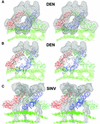Structures of immature flavivirus particles
- PMID: 12773377
- PMCID: PMC156766
- DOI: 10.1093/emboj/cdg270
Structures of immature flavivirus particles
Abstract
Structures of prM-containing dengue and yellow fever virus particles were determined to 16 and 25 A resolution, respectively, by cryoelectron microscopy and image reconstruction techniques. The closely similar structures show 60 icosahedrally organized trimeric spikes on the particle surface. Each spike consists of three prM:E heterodimers, where E is an envelope glycoprotein and prM is the precursor to the membrane protein M. The pre-peptide components of the prM proteins in each spike cover the fusion peptides at the distal ends of the E glycoproteins in a manner similar to the organization of the glycoproteins in the alphavirus spikes. Each heterodimer is associated with an E and a prM transmembrane density. These transmembrane densities represent either an EE or prMprM antiparallel coiled coil by which each protein spans the membrane twice, leaving the C-terminus of each protein on the exterior of the viral membrane, consistent with the predicted membrane-spanning domains of the unprocessed polyprotein.
Figures






References
-
- Baker T.S. and Cheng,R.H. (1996) A model-based approach for determining orientations of biological macromolecules imaged by cryoelectron microscopy. J. Struct. Biol., 116, 120–130. - PubMed
Publication types
MeSH terms
Substances
Associated data
- Actions
- Actions
- Actions
Grants and funding
LinkOut - more resources
Full Text Sources
Other Literature Sources

